Phenom 2 Variants are making their way to market, these initial offerings are AM3 backwards compatible with AM2+ Boards. We have one AM2+ and two AM3 CPU’s to look at today.
INTRODUCTION
AMD fielded the new Phenom 2 CPU’s right after CES 2009. Extreme cooling reports on the new line of Phenoms have them reaching insane speeds with LN2 and Liquid Helium. Most of us don’t have the luxury of Extreme cooling which can require as much as 3000 liters of liquefied gasses for a 90 minute glory run. Most of can field Liquid cooling if we want. It’s not as exotic, but it’s a lot more sustainable. So when we got the chance to test the new Phenom 2 line we chose to do it in a couple of stages. If you’d like to take a look at our first review of the Phenom 2 X4 940 BE you can take a gander at it over Here.
We released the AMD Dragon platform article on January 8th 2009 with the intention of coming back to it for a followup.
Then AMD surprised us and fielded two more Phenom 2 CPU’s before we got to the followup. So now we’re looking at the daunting task of covering the Phenom 2 X4 940 BE, Phenom 2 X4 810, and Phenom 2 X3 720 BE. That’s a lot of Phenom 2 goodness in one spot so you might want to grab your favorite beverage, kick your feet up and catch the low down on the new Phenom Dragon lineup.
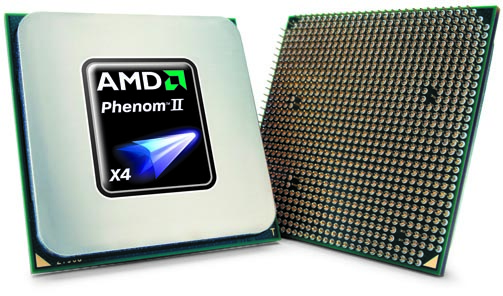
About AMD
Advanced Micro Devices (NYSE: AMD) is an innovative technology company dedicated to collaborating with customers and partners to ignite the next generation of computing and graphics solutions at work, home, and play.
Vision
A world where the amazing power of AMD technology improves the quality of people’s lives.
AMD set a goal to enable affordable, accessible Internet connectivity and computing capabilities for 50 percent of the world’s population by the year 2015. Learn more about AMD’s 50×15 Initiative.
Mission
Lead through innovative, customer-centric solutions that empower businesses, enhance the digital lifestyle, and accelerate global digital inclusion.
Values & Beliefs
AMD’s culture is characterized by an indomitable will to succeed and prosper in one of the world’s most challenging industries. At the heart of our unique and strong culture is the belief that people are the ultimate source of our competitive advantage. By living these core values, each one of us helps to deliver on our promises to customers, maximize shareholder value and ensure our enduring success.
Respect for People
We respect people, honor diversity and treat each other fairly. These are the cornerstones of our culture and key to our ability to work successfully as a global team. Learn about what it’s like to work at AMD.
Integrity
We operate with the highest standards of honesty and responsibility—as individuals and as a corporation—to be a role model worldwide through our business practices, community involvement and environmental stewardship. View our corporate responsibility mission and achievements.
Our Customers’ Success
We ensure our customers’ ongoing success by forging deep relationships founded on our commitment to meet their diverse technology needs and a shared passion for excellence. Read about how AMD drives customer success.
Customer-Centric Innovation
We lead through innovation—championing creative ideas and solutions that enable our customers to truly differentiate their solutions in the marketplace.
Initiative and Accountability
We deliver on our promises to our customers, stakeholders and to each other by taking risks, seeking proactive solutions and assuming ownership of the results.
At AMD, we take a measured approach to evaluate and continually improve global environmental efficiency, from how we run corporate facilities to how we develop products that deliver superior performance-per-watt. Learn more about AMD’s Green initiative at: www.amd.com/climate.
Fair and Open Competition
We believe that fair and open competition places the freedom of choice in the hands of customers, allowing the widest population to have access to the best possible technology.
| CPU Name | Cores | Clock | L2/L3 Cache | HT Bus | Socket | TDP | Price |
| AMD Phenom II X4 965 BE | 4 | 3.4GHz | 2+6MB | 4000MHz | AM3 | 140W | $179 |
| AMD Phenom II X4 955 BE | 4 | 3.2GHz | 2+6MB | 4000MHz | AM3 | 125W | $165 |
| AMD Phenom II X4 945 | 4 | 3.0GHz | 2+6MB | 4000MHz | AM3 | 125W | $159 |
| AMD Phenom II X4 925 | 4 | 2.8GHz | 2+6MB | 4000MHz | AM3 | 95W | $139 |
| AMD Phenom II X4 910e | 4 | 2.6GHz | 2+6MB | 4000MHz | AM3 | 65W | $169 |
| AMD Phenom II X4 905e | 4 | 2.5GHz | 2+6MB | 4000MHz | AM3 | 65W | $175 |
| AMD Phenom II X4 810 | 4 | 2.6GHz | 2+4MB | 4000MHz | AM3 | 95W | $139 |
| AMD Phenom II X3 720BE | 3 | 2.8GHz | 1.5+6MB | 4000MHz | AM3 | 95W | $104 |
| AMD Phenom II X3 710 | 3 | 2.6GHz | 1.5+6MB | 4000MHz | AM3 | 95W | $99 |
| AMD Phenom II X3 705e | 3 | 2.5GHz | 1.5+6MB | 4000MHz | AM3 | 65W | $119 |
| AMD Phenom II X2 555 | 2 | 3.2GHz | 1+6MB | 4000MHz | AM3 | 80W | $99 |
| AMD Phenom II X2 550 | 2 | 3.1GHz | 1+6MB | 4000MHz | AM3 | 80W | $91 |
| AMD Athlon II X4 635 | 4 | 2.9GHz | 2MB | 4000MHz | AM3 | 95W | $120 |
| AMD Athlon II X4 630 | 4 | 2.8GHz | 2MB | 4000MHz | AM3 | 95W | $102 |
| AMD Athlon II X4 620 | 4 | 2.6GHz | 2MB | 4000MHz | AM3 | 95W | $99 |
| AMD Athlon II X3 440 | 3 | 3.0GHz | 1.5MB | 4000MHz | AM3 | 95W | $84 |
| AMD Athlon II X3 435 | 3 | 2.9GHz | 1.5MB | 4000MHz | AM3 | 95W | $75 |
| AMD Athlon II X3 425 | 3 | 2.7GHz | 1.5MB | 4000MHz | AM3 | 95W | $72 |
| AMD Athlon II X2 255 | 2 | 3.1GHz | 2MB | 4000MHz | AM3 | 65W | $75 |
| AMD Athlon II X2 250 | 2 | 3.0GHz | 2MB | 4000MHz | AM3 | 65W | $65 |
| AMD Athlon II X2 245 | 2 | 2.9GHz | 2MB | 4000MHz | AM3 | 65W | $61 |
| AMD Athlon II X2 240 | 2 | 2.8GHz | 2MB | 4000MHz | AM3 | 65W | $53 |
FEATURES
Major feature enhancements for 45nm AMD Phenom II:
- Enhanced Total Cache: 8MB or 6MB (L2 + L3)
- Cool’n’Quiet 3.0 Technology: Additional power states, significantly (~40%) lower idle power and lower power consumption under moderate loads
- Increased frequencies
- Massive headroom using extreme and experimental cooling techniques
Major silicon enhancements for 45nm AMD Phenom II:
- 45nm immersion lithography manufacturing technology enables higher frequencies, tighter tolerances and lower current leakage
- 6MB L3 cache (up from 65nm Phenom’s 2MB)
- 2-cycles faster than 65nm Phenom L3
- Increased DRAM bandwidth
- Cache flush on halt: Core’s L1 and L2 flush into shared L3 after a core enters a halt state allowing the core to drop to a lower speed and save power
- Path-based indirect branch prediction
- 2x increase in core probe bandwidth
- Larger load/store buffering / larger floating point buffering / reduced MAB (missed buffer) lifetime
- Improved LOCK pipelineing: (LOCK is an instruction prefix) this improves performance when multiple LOCKS are in process simultaneously
- FP MOV compute optimization: Floating point register-to-register move instruction improvements
Phenom 2 Dragon Platform Aspect
As you probably already know AMD is the only CPU manufacturer that can field it’s own world class GPU’s and CPU’s which gave birth to the Dragon Platform concept. A fusion of GPU and CPU manufactured and designed to compliment each other. While this is a CPU performance review we will be covering the Graphics end of the Dragon Platform in yet another review of this new platform. In the mean time we wanted to touch on some of the Dragon Platform aspects.
Video Processing on a Radeon GPU:
Continuing on the topic of platform-level performance analysis… ATI has just released new Catalyst 8.12 drivers (for Windows and Linux) and a new version of AVIVO which provides a powerful tool for video processing. ATI Stream uses the massive parallel processing power of AMD graphics processors to deliver new capabilities to users that go beyond the traditional usage scenarios of graphics rendering and video processing.
Benefits:
- ATI Stream harnesses the processing power of the GPU for high-performance, data-intensive computations over a wide range of applications
- ATI Stream enables the hundreds of parallel cores inside AMD GPUs to accelerate general purpose applications
- These capabilities will allow ATI Stream-enabled programs to operate with optimized performance (or with new functionality) for a variety of different tasks and from a growing number of software vendors
- The CAL (Compute Abstraction Layer) is now included in the Catalyst driver package. CAL is the enabling component for ATI Stream
- Every owner of an ATI Radeon HD 4000-series card automatically gains the ability to run ATI Stream enabled applications
- Growing number of developers set to deliver ATI Stream enabled applications
ATI Stream application: ATI Avivo Video Converter
- Free download
- Low complexity, high value application
- Dramatically accelerates conversion of video files
- Optimized for file sizes common to HD video
Using ATI Stream technology, owners of ATI Radeon HD 4000-series graphics cards can take advantage of this video conversion tool (find it in Catalyst Control Center’s “Basic View”) to achieve incredible performance levels in video transcoding. We strongly urge you to test ATI Stream during your platform evaluation. You might consider it for an addition to your standard test suite. It should prove useful to test and quantify our raw performance, video processing prowess and demonstrating the platform benefits of Dragon platform technology.
Upcoming AM3 Phenom II processors:
The AMD Phenom II X4 940 and 920 processors launching in January are socket AM2+ compatible and support DDR2 memory. However, in early 2009 AMD will release its first AM3 Phenom II processors in both X4 and X3 flavors. These new AM3 processors will be compatible with both the current socket AM2+ and the upcoming socket AM3, supporting both DDR2 and DDR3. This approach allows users, businesses, system builders and OEMs to migrate across memory technologies at their own pace, when the time is right. AMD’s approach continues to be one of flexibility and compatibility to maximize platform longevity. In the current economic climate, we believe this approach makes more sense than ever.
Some Overclocking Tips (Black Edition)
Finding the maximum potential of your CPU is fairly straight forward with a “Black Edition” processor and the latest version of AMD OverDrive on a platform like the AMD 790GX-based motherboard which you’ll want to use with your processor. Here is some basic guidance to help get you on your way to voiding your warranty. Just remember, as always, “your mileage may vary.” Some chips will overclock better than others, but regardless… you roll the dice when you try. You can find the latest version of AMD Overdrive: http://game.amd.com/us-en/drivers_overdrive.aspx?p=1
Basic Overclocking Steps
- Increase CPU multiplier
- Use the HT reference clock slider in steps of 1-to-3 MHz for fine tuning (for less than 50MHz steps in CPU core clock)
- Increase CPU Voltage (VID)
Voltage Adjustment
By default the CPU voltage slider (CPU VID) in AMD OverDrive maxes at 1.45V. You can extend it to the max VID value of 1.550V by editing the “Preference.xml” file (with notepad.exe) in the AOD installation folder. Just find “MaxVcoreEnabled” and change it from “0” to “1”
Depending on the CPU and the cooling solution the optimal voltage can be anything between 1.40V (an air-cooled part that prefers low volts) and 1.95V (liquid nitrogen at -196C… assuming your processor demonstrates good voltage scaling)
For air-cooling our experts recommend testing from 1.40V up to 1.55V in 0.05V steps in order to find the optimal voltage
NOTE: its quite possible that you start seeing negative scaling after certain voltage point. Remember every CPU can be a little different
The only things you might want to adjust in the BIOS while overclocking are:
- Disable Cool’n’Quiet
- Disable C1E
- Disable Spread Spectrum
USING EXTREME COOLING (Liquid Nitrogen / Liquid Helium / etc.):
Here’s a tip if you’ve already hit ~5GHz and are looking for even more overclocking headroom with EXTREME cooling. For temperatures below the -70 to -100oC mark we suggest switching the CPU to HT 1.0 mode. Just adjust the “HT Link multiplier” item in the BIOS menu to “1GHz (x5)” mode. The CPU NB clock can still run at default (or overclocked) value – just the HT Link interface requires this adjustment for optimal temperature margin. As per the experience of our internal team, most CPUs overclock well at -190oC using HT1.0 settings. To get the best overclock possible, try setting HyperTransport to HT1 mode. This does not mean that HT Link must run at only 1.0GHz. You can tweak the HT reference clock to higher than the 200MHz default value which will increase the HT Link frequency and HT bandwidth. Try gradually working up with incremental jumps with an eye for a 300MHz HT reference clock (if possible with your chip). This would give a 1.5GHz HT Link speed.
HT3.0 Settings:
Though HyperTransport 3.0 is capable of higher frequencies than the northbridge/memory controller runs at, for best operation and performance, the HT speed should always be set to the SAME FREQUENCY as the memory controller specification for the particular CPU being tested. This can be done in the BIOS or in AMD Overdrive… or just left as-is (default settings) with proper BIOS support.
Example: the HT frequency for systems with the Phenom II X4 940 and 920 processors should be run at 1.8GHz, again the same frequency as the memory controller
DISCLAIMER
While Bjorn3D.com and AMD try to provide information as accurate as possible OCing is a crap shoot. Bjorn3D.com and AMD accept no responsibility for any attempt at OCing or any attempt at (what we have termed) Bone Head Stunts. No guarentee exists that you will be able to OC, or that your part will OC at all. It’s a crap shoot. OCing is a combination of carefully selected parts and OCing skill. As usual the contents on this site are provided “as is” without express or implied warranty.
In no case or special event shall Bjorn3D.com or AMD be held responsible for indirect or consequential damages or any damages whatsoever resulting from loss of income or profits, whether in an action of contract, negligence or other tortuous action, arising in connection with the use or performance of this information.
Bjorn3D has provided a number of links to external sites as a service to our readers, this should not be construed as any link between us and any entity or individule nor can we be held responsible for any content on their site.
Bjorn3D.com reserves the right to alter amend or delete any content without further notice.
Any reproduction of information from this site in partial or full is strictly prohibited and will result in legal action unless you have prior written permission from the site owner, or Management Staff.
With that being said: Let the Bone Head Stunts Begin
AMD Phenom X4 CPU Specifications
| AMD Phenom II X4 (AM2 Package) Specifications |
|
| Processor Frequency | X4 940 (Black Edition) = 3.0GHz X4 920 = 2.8GHz |
| Cache Sizes | L1 Cache Sizes: 64K of L1 instruction and 64K of L1 data cache per core (512KB total L1 per processor)
L2 Cache Sizes: 512KB of L2 data cache per core (2MB total L2 per processor) L3 Cache Sizes: 6MB (shared) |
| Memory Controller Type: | Integrated 128-bit wide memory controller * (See Note) |
| Memory Controller Speed | Up to 1.8GHz with Dual Dynamic Power Management |
| Types of Memory Supported | Support for unregistered DIMMs up to PC2 8500 (DDR2-1066MHz) |
| Memory Bandwidth | Up to 17.1GB |
| HyperTransport 3.0 Link | One 16-bit/16-bit link @ up to 3.6GHz full duplex (1.8GHz x2) |
| HyperTransport 3.0 Bandwidth | Up to 14.4GB/s |
| Total Processor Bandwidth | Up to 31.5 GB/s total bandwidth |
| Packaging | Socket AM2+ 940-pin organic micro pin grid array (micro-PGA) |
| Fab location | Fab 36 wafer fabrication facilities in Dresden, Germany |
| Process Technology | 45-nanometer DSL SOI (silicon-on-insulator) technology |
| Approximate Transistor count | ~ 758 million (45nm) |
| Approximate Die Size | 258 mm2 (45nm) |
| Max Ambient Case Temp | 62o Celsius |
| Nominal Voltage | 0.875 – 1.5 Volts |
| Max TDP | 125 Watts |
| NOTE: * MC configurable for dual 64-bit channels for simultaneous read/writes | |
Phenom 2 General Specifications
| AMD Phenom II X4 + X3 (AM3 Package Backwards Compatible AM2+) Specifications |
|
| Processor Frequency | X4 810 = 2.6 GHz 4MB L3 X3 720 Black Edition 2.8GHz 6MB L3 X3 710 = 2.6GHz 6MB L3 X4 910 = 2.6GHz 6MB L3 X4 805 = 2.5GHz 4MB L3 |
| Cache Sizes | L1 Cache Sizes: 64K of L1 instruction and 64K of L1 data cache per core (512KB total L1 per processor)
L2 Cache Sizes: 512KB of L2 data cache per core L3 Cache Sizes: 6MB (shared) or L3 Cache Sizes: 4MB (shared) |
| Memory Controller Type: | Integrated 128-bit wide memory controller * (See Note) |
| Memory Controller Speed | Up to 2 GHz with Dual Dynamic Power Management |
| Types of Memory Supported | Support for unregistered DIMMs up to PC2 8500 (DDR2-1066MHz) AM2+ Board Support for unregistered DIMMs up to PC3 10666 (DDR3-1333MHz) AM3 Board |
| Memory Bandwidth | Up to 17.1GB |
| HyperTransport 3.0 Link | One 16-bit/16-bit link @ up to 4.0 GHz full duplex (2.0GHz x2) |
| HyperTransport 3.0 Bandwidth | Up to 16 GB/s |
| Total Processor Bandwidth | Up to 33.1 GB/s total bandwidth |
| Packaging | Socket AM2+ 940-pin organic micro pin grid array (micro-PGA) or Socket AM3 938-pin organic micro pin grid array (micro-PGA) |
| Fab location | Fab 36 wafer fabrication facilities in Dresden, Germany |
| Process Technology | 45-nanometer DSL SOI (silicon-on-insulator) technology |
| Approximate Transistor count | ~ 758 million (45nm) |
| Approximate Die Size | 258 mm2 (45nm) |
| Max Ambient Case Temp | 71o Celsius / X4 73o Celsius / X3 |
| Nominal Voltage | 0.875 – 1.425 Volts |
| Max TDP | 95 Watts |
| NOTE: * MC configurable for dual 64-bit channels for simultaneous read/writes **NOTE: for DDR3-1333, AM3 boards will support 1-DIMM-per-channel @ 1333MHz |
|
Individule CPU Specifications
| AMD CPU Specs | ||||||||
| Model | Clock Speed | System Bus Speed | Package Profile | Voltage | Max Temp | TDP | Total L2 Cache | Total L3 Cache |
| 940 X4 (Black Edition) | 3.0 GHz | 3.6 GT/s | Socket AM2+ | 0.875-1.5v | 62°C | 125w | 2MB | 6MB |
| 920 X4 | 2.8 GHz | 3.6GT/s | Socket Am2+ | 0.875-1.5v | 62°C | 125w | 2MB | 6MB |
| 810 X4 | 2.6 GHz | 4.0 GT/s | Socket Am2+ or AM3 | 0.875-1.425v | 71°C | 95w | 2MB | 4MB |
| 910 X4 | 2.6 GHz | 4.0 GT/s | Socket Am2+ or AM3 | 0.875-1.425v | 71°C | 95w | 2MB | 6MB |
| 805 X4 | 2.5 GHz | 4.0 GT/s | Socket Am2+ or AM3 | 0.875-1.425v | 71°C | 95w | 2MB | 4MB |
| 720 X3 (Black Edition) | 2.8 GHz | 4.0 GT/s | Socket Am2+ or AM3 | 0.875-1.425v | 73°C | 95w | 2MB | 6MB |
| 710 X3 | 2.6 GHz | 4.0 GT/s | Socket Am2+ or AM3 | 0.875-1.425v | 73°C | 95w | 2MB | 6MB |
Prices At time of Posting
Pricing
- $229 AMD Phenom™ II X4 940 Black Edition Pricing at time of Post
- $189 AMD Phenom™ II X4 920 Pricing at time of Post
- $175 AMD Phenom™ II X4 810 Lots of 1000 to Vendors
- $145 AMD Phenom™ II X3 720 Black Edition Lots of 1000 to Vendors
- $125 AMD Phenom™ II X3 710 Lots of 1000 to Vendors
- $Unknown AMD Phenom™ II X4 910 (Available in tray only)
- $Unknown AMD Phenom™ II X4 905 (Available in tray only)
- AMD’s official pricing page will be updated after launch:
- http://www.amd.com/us-en/Processors/ProductInformation/0,,30_118_609,00.html?redir=PR001
PICTURES & IMPRESSIONS
As you might guess we’re dealing with CPU’s so your not dealing with a product that is real conducive to a plethora of pictures. Knowing that we’re going to toss in a few tidbits that need to be covered to provide a little more relevant content.
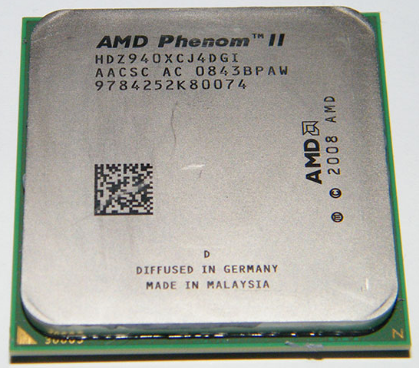
Like we mentioned it’s a CPU except for minor variations they all look just about alike. In case you’ve ever wondered how we receive them we snapped a shot of them as soon as we opened the case. The large picture above is the AMD Phenom 2 X4 940 BE, the big dog of the lineup so far.
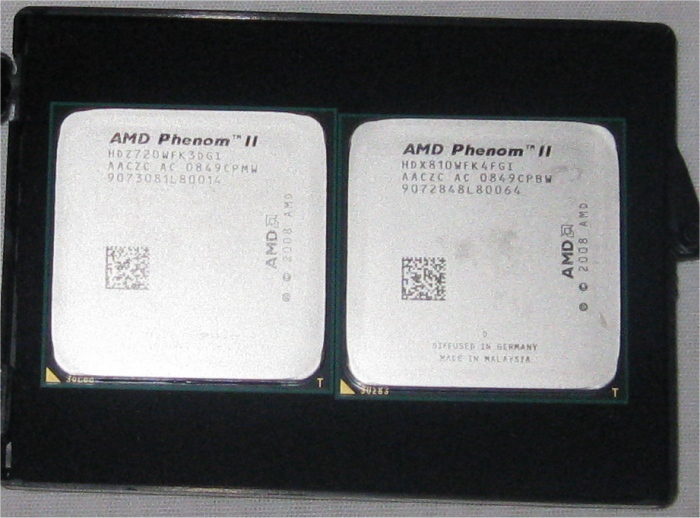
Unceremoniously delivered in a plain black box with a little golden logo saying AMD on the outer case we opened it to find not one but two Phenom 2’s held securely by the foam and rubber band around the case. The CPU on the left is the Phenom 2 X3 720 Black Edition. It’s the new triple core variant of the Phenom 2 lineup and features an unlocked multiplier. The CPU on the right is the Phenom 2 X4 810 and unlike the 940 X4 BE it has a locked multiplier and you’ll have to use a FSB overclock to get any OC out of that little jewel. The Phenom X3 720 BE and X4 810 are the first of the AM3 (backwards compatible with AM2+) CPU’s to hit the market. The difference between the AM2+ and AM3 CPU’s (Other than the Motherboard) is that the AM3 package CPU’s will be able to drive DDR3 on an AM3 board and DDR2 if used on an AM2+ board. The 940 and 920 AM2+ package are only used on AM2+ boards and will only drive DDR2.
While we would have liked to strap the new CPU’s into an AM3 board, we were asked by AMD to go ahead and test the X3 720 and X4 810 on AM2+ boards because they are still working with the programmers that write the BIOS for the boards to work kinks out of the AM3 BIOS. Since all of the new Phenom 2 series are compatible with AM2+ boards we don’t have a problem with that, but reserve the right to go back and revisit the CPU’s on an AM3 board as they come available and mature a little.
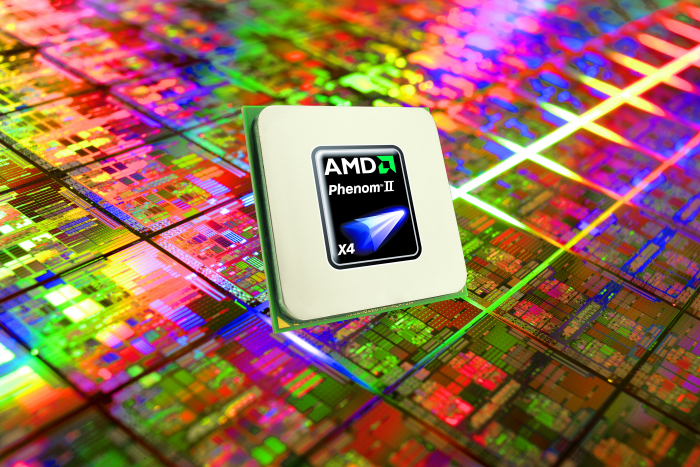
In this one you get the beauty shot of the CPU with a Phenom 2 X4 logo on it but that’s not why we wanted to post the shot. Behind the CPU is the actual wafer with etched CPU’s ready to be laser cut from the wafer. How would you like to have one of those bad boys to hang on the wall.
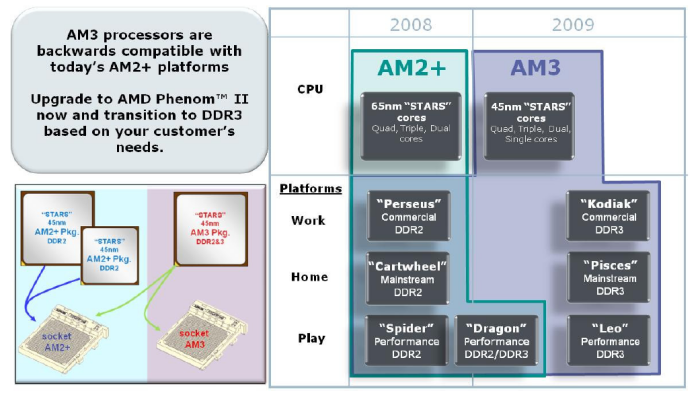
We always like to know what direction a particular platform is headed so we snagged this graphic from the AMD FTP. Like we mentioned, the X4 940 BE and X4 920 are strictly AM2+ capable, moving to the AM3 package CPU’s we were pleased to find out that they are indeed backwards compatible with AM2+ boards. That’s a big plus for the Dragon platform. With the Intel current offerings, Core i7 1366 CPU’s you have to go to a new X58 board, and DDR3 ram, preferably Triple Channel DDR3. The initial layout for CPU, Ram and Board all at once has pushed a lot of people into waiting for price drops and purchasing one component at a time to move to the new platform. With the Dragon lineup all you need is a compatible AM2+ board and inexpensive DDR2 which most of us already have (Meaning DDR2 Ram), spring for a new Phenom 2 CPU of choice and your good to go. Provided your board will support the CPU, most manufacturers are in the process of redoing BIOS’s for current AM2+ boards to make them compatible with Phenom 2. The one exception you will have to be careful on is the higher wattage Phenom 2 CPU’s. While the newer 95w CPU’s should work in almost any board, some of the Phenom 2 CPU’s require a board that will push 125w.
Now on the same tack, a low end Intel 920 Core i7 will set you back about $280, then a good board because you are going to want to OC that puppy so toss in another $300, then a good set of Triple Chanel DDR3 for another $250 and your out of pocket $830 give or take depending on the quality of equipment you want. Spring $224 (at the time of posting) for an X4 940 BE and enjoy an unlocked multiplier on your existing AM2+ board with whatever flavor of DDR2 you already have. Your not going to run at the same level as the i7 CPU is capable of performance wise, but you can do it $606 dollars cheaper. In a sagging economy it makes sense and for those already on the AMD path it makes a lot of sense. If your not AM2+ capable already, worst case (no components), then you can locate a decent AM2+ board for $100, an X4 940 for $224, and a set of decent ram for $60. Total outlay for CPU, board and ram $384 and your setting on a very capable Quad with an unlocked multiplier and having one heck of a lot of fun overclocking and tweaking. Top end Phenom 2 for $384, or entry level Core i7 for $830 that’s a choice you, and the economy are going to have to wrestle with. If your willing to go for one of the locked multiplier CPU’s or even a Black Edition X3 the the AMD path gets considerably cheaper.
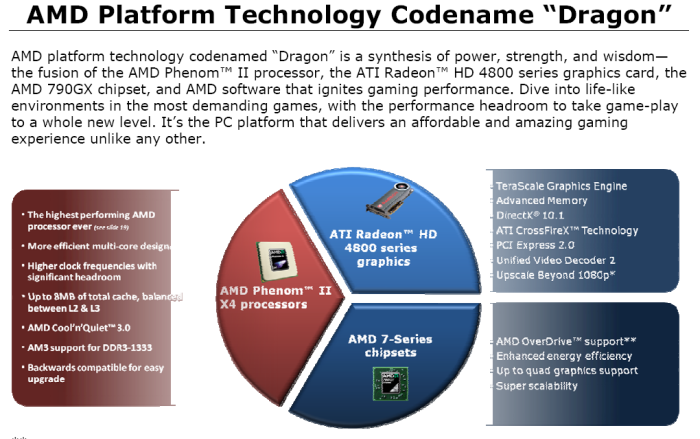
Earlier we spoke of the Dragon Platform, to that end we snagged another graphic because, well we like graphics. The AMD Dragon Platform is the fusion of an AMD Phenom 2 CPU on an AMD 7 series chipset with an ATI Radeon GPU. While we’re focusing on the CPU performance end of things in this review, we have seen and tested the Dragon Platform as a whole and we have to tell you that for all intents and purposes it’s more than your average computer user needs. It’s enough for most enthusiast users. We didn’t see any games or applications that needed more horsepower to drive than exists in the Dragon Platform which confirms a lot of what we’ve been seeing through the last few platforms,computing power is exceeding current computing needs for most users. Core i7 is probably a little more future proof, but current applications and games run great on the Dragon platform and do it for about half the cost of the Intel Core i7 platform.
We’re not knocking the Intel platforms performance by any means, no-one is disputing the power of the current Core i7 platform, but the cost of the equipment and the initial layout is making a lot of people wait to move to the new technology. AMD has managed to slip in and provide a great price/performance ratio platform now. Not only that they’ve made it compatible with existing hardware and an easy upgrade path from AM2+ to AM3 and DDR3.
TESTING & METHODOLOGY
To test the Phenom 2 CPU’s we did a fresh load of Vista 64 and applied all the latest patches and updates. We also updated the motherboard drivers to the latest versions and checked to make sure we were using the latest BIOS. Once we had all the patches installed, motherboard drivers up to date, and all the little things that need to be done to bring a system up to snuff we cloned the drive using Acronis to keep the load safe from any little overclocking accidents we might have.
Speaking of overclocking accidents, we thought we’d privy you to a little information about that on this review. We tend to get in a hurry and when you do that things happen. We bricked at least two OS installs overclocking a little to aggressively. No fault of the equipment we assure you, but OCing accidents happen which is why we clone with Acronis and encourage anyone OCing to do the same. That spare drive that might cost you $50 is pretty cheap compared to reloading the OS 3 or 4 times during an extended overclocking session.
Along the same lines, on this review in particular the overclocks we managed are more a reflection of the amount of time that we had to spend with the product before the NDA (Non-disclosure agreement) lifts than the equipment itself. By that we mean 2 weeks spent with the New Phenom 2 CPU’s (3 of them) and a new never before used motherboard isn’t enough time to say “These are the maximum OC’s we achieved and we believe that these are the best overclocks we can get.” We know they’re not the best OC’s we can get but they are the best OC’s we can get in the allotted time we had with the product before it was time to post the review. With more time and experience on the platform and motherboard we know we can achieve higher overclocks so please take that into consideration.
Test Rigs
We decided that since no matter what we do or say that the information about the review of Intel and AMD CPU’s people are going to look at them side by side and draw conclusions. To that end we used the same CPU cooler on all of the CPU’s. We used the Thermalright Ultra 120 with the same two fans for every CPU. We also used the Intel 80 GB Solid State Drive for every CPU reviewed. We also used the 4870X2 for all of the data obtained in this review on every CPU.
We used the same hard drive, same CPU cooler, and same GPU on all the platforms in an attempt to make the data as relevant as possible. We don’t think that it would be a fair comparison to use a high end SSD on the Intel platform and one of the top CPU coolers without extending the same courtesy to the AMD platform. To do so would make it a lopsided review and bias the numbers. So if you browse other CPU reviews one of the things you should be looking for and asking yourself is “Did the site use the Intel review kit items for all the CPU’s or did they use a traditional platter drive for the AMD CPU’s”. If they did it will make a tremendous difference in the platform numbers, we tested with and without SSD and the difference was large enough to invalidate data obtained using a platter drive against an SSD. To that end we used the same hard drive, CPU cooler and GPU on all of the CPU’s contained in this review.
Hardware Common To All The Test Rigs
- Thermaltake Tough Power 1200 Watt
- Intel 80 GB SSD
- Palit 4870×2
- Razer Lycosa
- Razer Lachesis
- Top Deck Testing Station Chassis
- Thermalright Ultra 120 w/2 83CFm Yate Loon Fans
- LG DVD/RW
So you can pretty much see that the only platform differences are going to be Motherboard, CPU, and Ram. In a cross platform test that’s about as good as you can get.
Platform Specific Hardware
- Phenom 2 X4 940 BE CPU Equipment
- MSI DKA790GX Platinum
- Crucial Ballistix DDR2 1066 4 GB Kit
- For more information on the MSI DKA790GX Platinum you can visit the MSI Website Here
- Phenom 2 X4 810 and X3 720 BE CPU Equipment
- Asus M3A78-T
- Crucial Ballistix DDR2 1066 4 GB Kit
- For more information on the Asus M3A78-T you can visit the Asus Website Here
- Intel Core I7 965 Equipment
- Asus P6T Deluxe
- Kingston HyperX Triple Channel DDR3 2 GHz
- For more information on the Asus P6T Deluxe you can see our review Here
- For more information on the Core i7 965 you can see our review Here
- Intel Q6600 Equipment
- EVGA 790I
- Crucial Ballistix DDR3 1333 4 GB Kit
- For more information on the EVGA 790I you can see our review Here
- Intel E8400 Equipment
- Gigabyte EP45-Extreme
- Crucial Ballistix DDR2 1066 4 GB Kit
- For more information on the Gigabyte EP45-Extreme you can read our review Here
Just in case you were wondering, yes we have all those beautiful machines here in one spot up and running, not in the configuration we used in this review but yes they are all here in one spot running and fully functional, along with a stack of GPU’s that would make a grown man cry, and a stack of high end ram that would make you pull your hair out, and a stack of high end Hard Drives that will make you drool. We were deprived as children, we had the Atari console, we’re making up for it now.
Before we move onto the Testing Suite section lets get this out of the way. We ran all the CPU’s at stock Speed during testing, then we ran the AMD CPU’s at the best OC we could get in the time we had. We already know that some people are going to yell because we didn’t OC the Intel CPU’s in the review. If you want to see the Intel overclocks and results of those we have separate reviews for 3 of the Intel Core I7 CPU’s, each one contains OC information and testing. Feel free to browse those and compare numbers to this review. You can spend half a lifetime OCing and charting results in all the possible combination’s. We run each CPU at stock speed for comparison purposes, then the CPU being reviewed we OC that one. You might not even get an OC out of the same model CPU and unless it’s on the same board with the same ram and the OC is done identically the numbers won’t be the same.
Test Suite
|
Synthetic Benchmarks |
|
3DMark Vantage v. 1.01 |
|
3DMark06 v. 1.1.0 |
|
SiSoft SANDRA XII Professional SP2 |
|
Everst Ultimate Edition v. 4.50.1330 |
|
SuperPi Mod 1.5XS |
|
Cinebench R10 64 bit |
|
WinRar v. 3.71 |
3DMARK06 V. 1.1.0

3DMark06 developed by Futuremark, is a synthetic benchmark used for universal testing of all graphics solutions. 3DMark06 features HDR rendering, complex HDR post processing, dynamic soft shadows for all objects, water shader with HDR refraction, HDR reflection, depth fog and Gerstner wave functions, realistic sky model with cloud blending, and approximately 5.4 million triangles and 8.8 million vertices; to name just a few. The measurement unit “3DMark” is intended to give a normalized mean for comparing different GPU/VPUs. It has been accepted as both a standard and a mandatory benchmark throughout the gaming world for measuring performance.
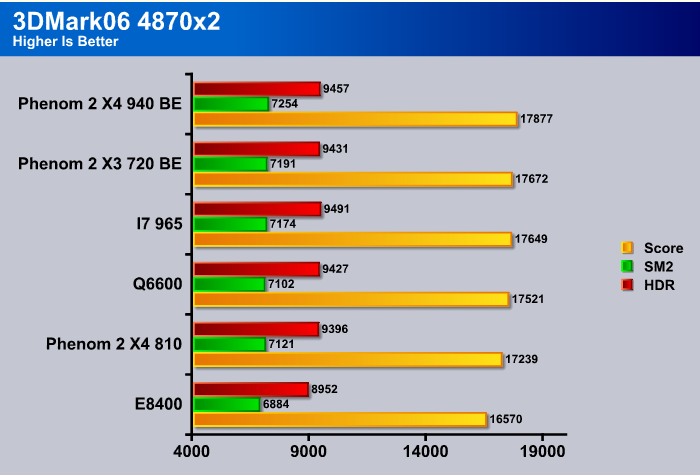
From our previous review of the Phenom 2 X4 940 we already know that in combination with the Dragon platform as a whole it’s no slouch when it comes to graphics. The score between the X4 940, X3 720 and the Core i7 965 are so close that it would be hard to make a definitive call. Credit where it’s due though at stock clocks the Phenom series CPU’s did well in 3DMark06 when combined with the Palit 4870×2.
3DMark Vantage
For complete information on 3DMark Vantage Please follow this Link: www.futuremark.com/benchmarks/3dmarkvantage/features/
The newest video benchmark from the gang at Futuremark. This utility is still a synthetic benchmark, but one that more closely reflects real world gaming performance. While it is not a perfect replacement for actual game benchmarks, it has its uses. We tested our cards at the ‘Performance’ setting.
Currently, there is a lot of controversy surrounding NVIDIA’s use of a PhysX driver for its 9800 GTX and GTX 200 series cards, thereby putting the ATI brand at a disadvantage. Whereby installing the PyhsX driver, 3DMark Vantage uses the GPU to perform PhysX calculations during a CPU test, and this is where things get a bit gray. If you look at the Driver Approval Policy for 3DMark Vantage it states; “Based on the specification and design of the CPU tests, GPU make, type or driver version may not have a significant effect on the results of either of the CPU tests as indicated in Section 7.3 of the 3DMark Vantage specification and white paper.” Did NVIDIA cheat by having the GPU handle the PhysX calculations or are they perfectly within their right since they own Ageia and all their IP? I think this point will quickly become moot once Futuremark releases an update to the test.
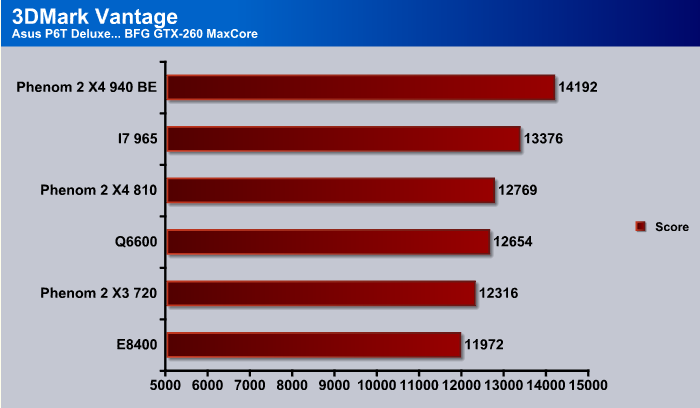
Moving to 3DMark Vantage which is a little more modern tool for determining CPU/GPU performance than 3DMark06 because it’s more multi-thread friendly we were surprised to see the Phenom X4 940 Black Edition ahead of the Core i7 965. Of course the X4 940 BE has the advantage of running the Dragon Platform configuration and the CPU, Motherboard, and GPU are designed and optimized to run together so it’s not to big of a surprise. It does show however that for gaming purposed the Dragon Platform isn’t to be sneezed at and with some OCing and optimization time could be a true force in the gaming world.
Cinebench
“CINEBENCH is a real-world test suite that assesses your computer’s performance capabilities. MAXON CINEBENCH is based on MAXON’s award-winning animation software, CINEMA 4D, which is used extensively by studios and production houses worldwide for 3D content creation. MAXON software has been used in blockbuster movies such as Spider-Man, Star Wars, The Chronicles of Narnia and many more. MAXON CINEBENCH runs several tests on your computer to measure the performance of the main processor and the graphics card under real world circumstances. The benchmark application makes use of up to 16 CPUs or CPU cores and is available for Windows (32-bit and 64-Bit) and Macintosh (PPC and Intel-based). The resulting values among different operating systems are 100% comparable and therefore very useful with regard to purchasing decision-making. It can also be used as a marketing tool for hardware vendors or simply to compare hardware among colleagues or friends.”

When we get to Cinebench we start to se the platform specific differences show. The Core i7 965 easily passes anything we tested for this review, but you still have to take into consideration Price/Performance. The Core i7 platform we’re showing in this test cost well above $3000 and on any given day with our favorite toys attached can run as high as $5000. Just the bare minimum on QuadZilla, the CPU, Motherboard and Ram run $1600 toss on the Palit 4870×2 and your looking at above $2000. The same components on the Phenom 2 X4 940 including GPU run $835. Your seeing 2/3 the performance of the Core i7 965 at less than 1/2 the cost so it’s hard to justify a direct comparison of the two platforms. Getting closer to it’s price point the Q6600 and the Phenom 2 X4 940 are pretty comparable. Overclocked the X4 940 out ran the Q6600, but at stock clocks the Q6600 outran the X4 940 Black Edition. You have to keep in mind though that the Q6600 is still a very capable popular CPU that most people are happy with so that puts the X4 940 in the same class and it’s a lot more fun to OC.
Looking at the price point comparison for the Phenom 2 X3 720 which is the Intel E8400 the Phenom X3 720 Black Edition takes the lead over the E8400. That’s to be expected because the X3 720 BE is a triple core CPU and Cinebench can take advantage of the extra core on the X3 720. Again we hit 3.4 GHz on the X3 720 but we’re not done with it, it’s a Black Edition CPU and we know we can get more out of it but bringing all the test rigs up to snuff for this review and switching out equipment ate all our time. We know there’s more to get and since it’s an unlocked multiplier we know we can get more from it we just didn’t have time. The Intel E8400 Overclocked will probably take the lead in less multi-threaded applications, but multi-threaded applications will like the Phenom X3 720 Black Edition better.
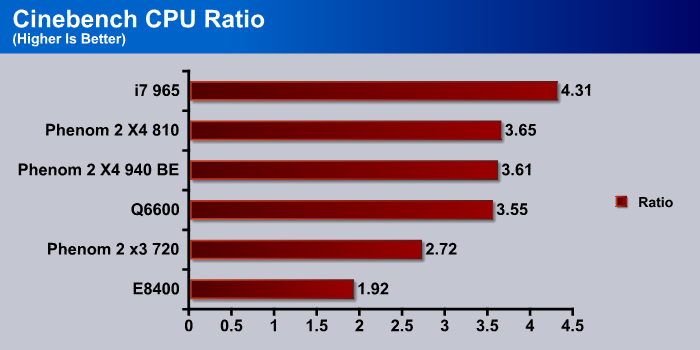
Cinebench CPU Ratio’s, we’re not sure how much use this information is with the platforms so widely different but it makes a nice lead in for the shot of Cinebench we got running the Phenom 2 X3 720 Black Edition.
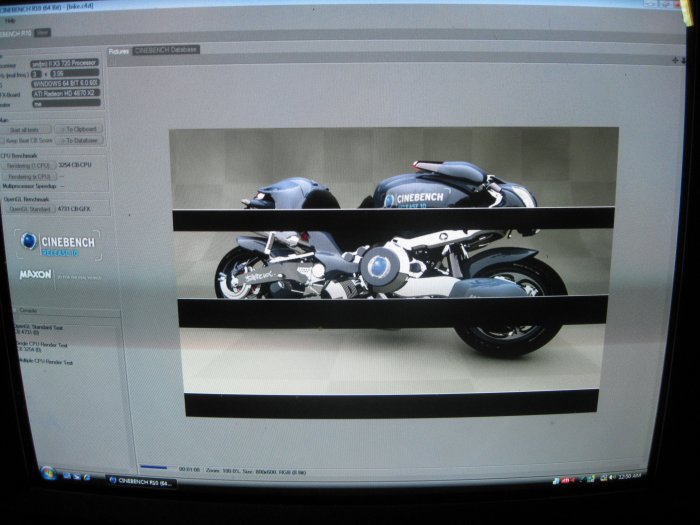
We we’re so used to dual core and quad core CPU’s running on Cinebench that it was a treat seeing a Triple Core CPU running Cinebench. Notice how the picture being rendered is split into 3 sections, one for each Core. It was a little bit of a reality check, Triple Core CPU’s offer a lot of savings for people that mainly game and would like a little extra oomph for heavily multi-threaded applications. The Phenom X3 720 Black Edition unlocked multiplier didn’t hurt our feelings any when we got to playing with it. If you’ve never experienced the joys of an unlocked multiplier you should treat yourself at least once in this life and spring for one. Unlocked multipliers open up a whole new world of performance possibilities and are just downright fun to OC.
WinRar v. 3.71
This module in WinRar generates random data, which contains specially introduced redundancy, increasing the load to both the processor and memory. Data is then passed through RAR compression and decompression algorithms, and the output of the decompression algorithm is compared to the source data. If any differences are found, WinRAR then reports “Errors found – Yes” in the command window. WinRAR displays a size of processed data and compression speed, current and resulting, in kilobytes per second.

Once again the more expensive Core i7 965 tops out the chart in WinRar, with it’s Quad core and Hyperthreading it trashes the rest of the CPU’s in the chart. Dropping back to reality in the price point comparison the Phenom X4 940 BE outperforms our old favorite the Intel Q6600 at it’s stock speed. Apply some OC to the Q6600 and it’s anybodies game. We were surprised by the X4 810 and X3 720 putting that much of a whipping on the Intel E8400. We really wish we’d have had another couple of weeks with the Phenom Dragon platform for some more tuning and learning. Even in single threaded tests the X3 720 Black Edition managed to squeeze out the E8400 which caused us to rerun the tests a few times but even retesting didn’t change the numbers.
EVEREST ULTIMATE
“EVEREST Ultimate Edition is an industry leading system diagnostics and benchmarking solution for enthusiasts PC users, based on the award-winning EVEREST Technology. During system optimizations and tweaking it provides essential system and overclock information, advanced hardware monitoring and diagnostics capabilities to check the effects of the applied settings. CPU, FPU and memory benchmarks are available to measure the actual system performance and compare it to previous states or other systems. Furthermore, complete software, operating system and security information makes EVEREST Ultimate Edition a comprehensive system diagnostics tool that offers a total of 100 pages of information about your PC.”
Everest Memory
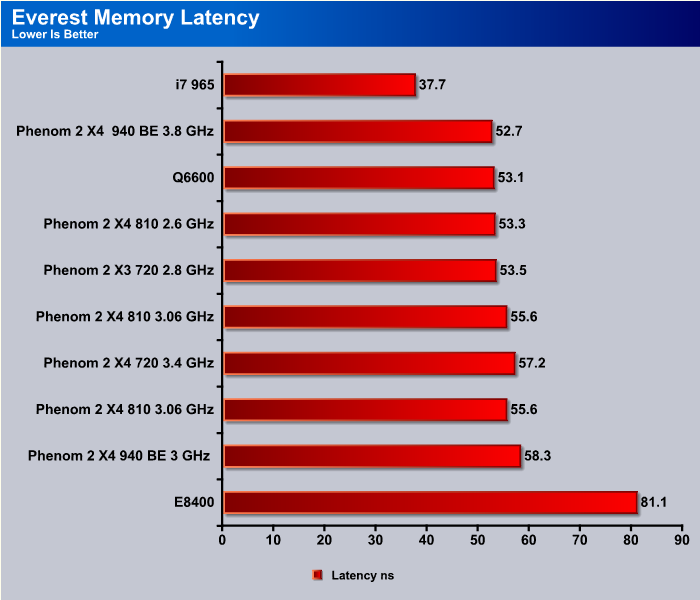
The Core i7 platform now sports an on CPU memory controller which offers increased efficiency and support for triple channel memory, it tops the chart for lowest latency. The rest of the CPU’s on the charts come out reasonably close in the latency department with the exception of the E8400 and it’s being run on an Nvidia chipset and in the configuration we had the memory (Unlinked) it turned in the highest latency.
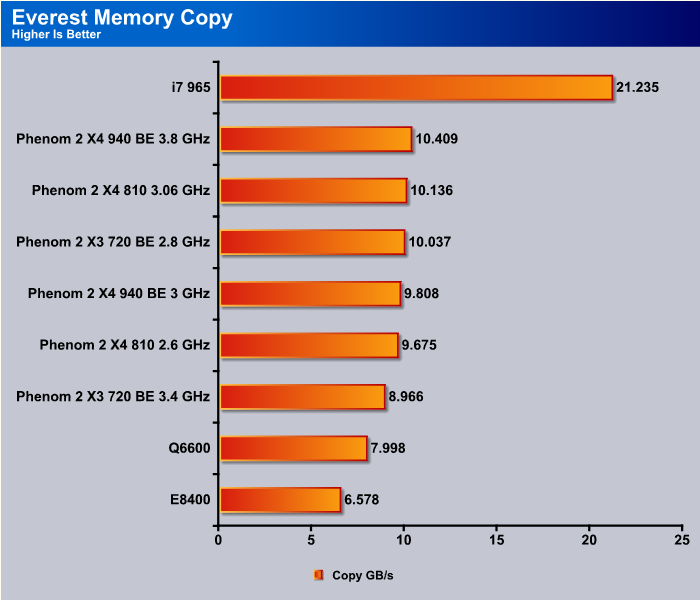
Previous to Core i7 AMD held the memory crown for a lot of years. The reason for that, prior to Core i7, was that AMD went to an integrated memory controller on the CPU long before Intel adopted it for Core i7. When Intel adopted the on CPU memory controller and went to triple channel memory DDR3 came of age. Core i7 hold the memory bandwidth crown now, but as you can see the AMD chips all top Intel’s previous socket 775 platform Core 2 Duo and Core 2 Quad CPU’s.

We don’t see any big surprises in the memory read department, Core i7 and it’s triple channel memory dominate the field followed by all the AMD CPU’s we tested, then the previous generation 775 chips come in behind the AMD chips.
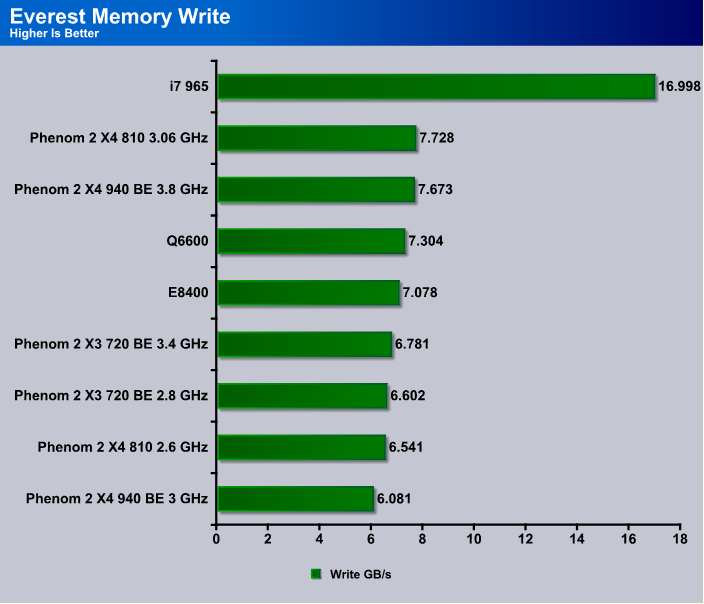
We were surprised to see the Intel Socket 775 CPU’s jump up in the charts in the Everest write test. Core i7 naturaly came out on top followed by the overclocked Phenom X4 810 and X4 940. The E8400 and Q6600 slid into 4th and 5th, we were surprised enough to repeat the test a few additional times but the numbers, like usual, didn’t change.
Everest CPU
CPU AES
This integer benchmark measures CPU performance using AES (a.k.a. Rijndael) data encryption. It utilizes Vincent Rijmen, Antoon Bosselaers and Paulo Barreto’s public domain C code in ECB mode.
CPU AES test uses only the basic x86 instructions, the test consumes 48 MB memory, and it is Hyper Threading, multi-processor (SMP) and multi-core (CMP) aware.

Everest CPU AES is heavily multi-threaded which is why it’s a good measure of a multi-core CPU’s power. It’s rather interesting that the Core i7 965 and the Overclocked Phenom X4 940 BE came in so close in this test considering that Intel’s Core i7 platform is Hyper Transport enabled (4 cores are split virtually into 8 cores). One of our old favorites the Q6600 did pretty well in this test followed by the rest of the pack of AMD CPU’s and the E8400 in last because it’s a dual core CPU.
CPU PhotoWorxx
This integer benchmark performs different common tasks used during digital photo processing.
It performs the following tasks on a very large RGB image:
• Fill
• Flip
• Rotate90R (rotate 90 degrees CW)
• Rotate90L (rotate 90 degrees CCW)
• Random (fill the image with random colored pixels)
• RGB2BW (color to black & white conversion)
• Difference
• Crop
This benchmark stresses the integer arithmetic and multiplication execution units of the CPU and also the memory subsystem.
CPU PhotoWorxx test uses only the basic x86 instructions, and it is Hyper Threading, multi-processor (SMP) and multi-core (CMP) aware.
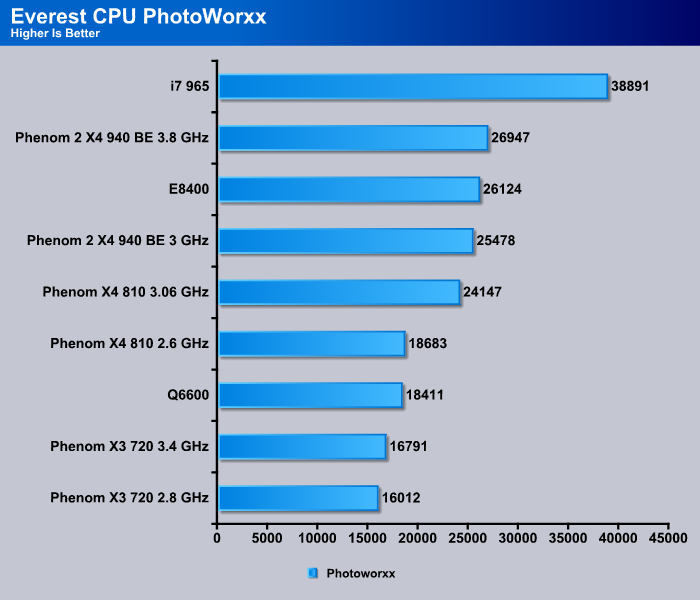
Benching hardware never ceases to amaze us. In this test Core i7 965 comes out on top followed by the Phenom 2 X4 940 BE. that’s ot what amazed us though, in the last test the Q6600 dominated the E8400 but their roles have reversed in this test. This result makes us question the quality of the multi-threaded support in PhotoWorxx.
CPU Queen
This simple integer benchmark focuses on the branch prediction capabilities and the misprediction penalties of the CPU. It finds the solutions for the classic “Queens problem” on a 10 by 10 sized chessboard.
CPU Queen test uses integer MMX, SSE2 and SSSE3 optimizations. It consumes less than 1 MB system memory and it is Hyper Threading, multi-processor (SMP) and multi-core (CMP) aware.

In CPU Queen the Core i7 965 and Q6600 come out on top, the Q6600 is followed by the Phenom 2 940 BE and X4 810 when they are overclocked. Then the X4 940 and X4 810 at stock speeds are next in line followed by the Triple Core Phenom X3 720 BE. Pulling last place because of it’s dual core nature is the Intel E8400.
CPU ZLib
This integer benchmark measures combined CPU and memory subsystem performance through the public ZLib compression library Version 1.2.3 (http://www.zlib.net).
CPU ZLib test uses only the basic x86 instructions, and it is Hyper Threading, multi-processor (SMP) and multi-core (CMP) aware.
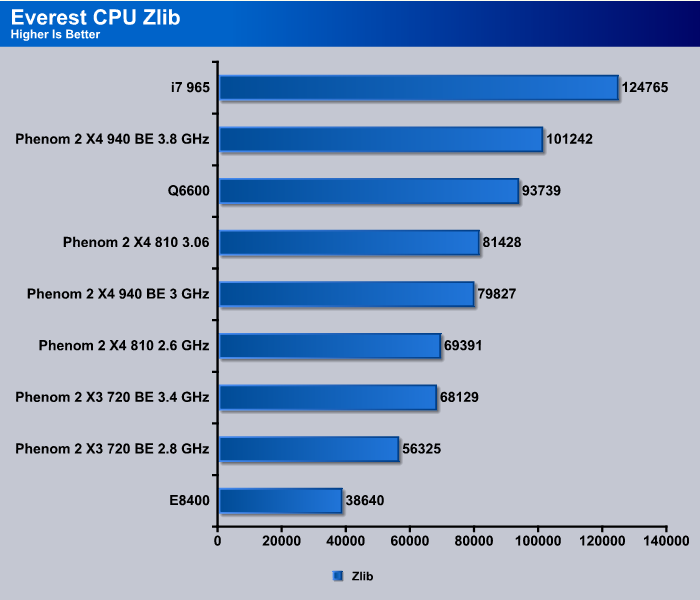
Core i7 965 comes in on top the chart again in Everest’s CPU ZLIB test but what really amazes us is that a Phenom 2 X4 940 BE that costs 1/4 what the Core i7 965 costs comes that close to it’s score. The AMD Phenom 2 CPU’s are showing a good price/performance ratio.
Sisoft Sandra 2009 SP1
“SiSoftware Sandra (the System ANalyser, Diagnostic and Reporting Assistant) is an information & diagnostic utility. It should provide most of the information (including undocumented) you need to know about your hardware, software and other devices whether hardware or software. It works along the lines of other Windows utilities, however it tries to go beyond them and show you more of what’s really going on. Giving the user the ability to draw comparisons at both a high and low-level. You can get information about the CPU, chipset, video adapter, ports, printers, sound card, memory, network, Windows internals, AGP, PCI, PCI-X, PCIe (PCI Express), database, USB, USB2, 1394/Firewire, etc.”
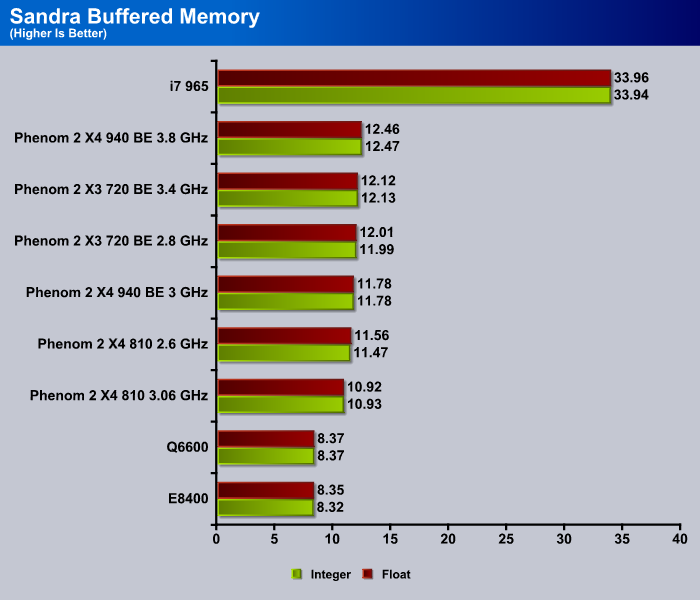
When it comes to memory testing with CPU’s you can just about predict the order they will score in without even looking at the results. Core i7 comes in on top, followed by every AMD CPU since they integrated the memory controller, then all the Intel 775 and below platform CPU’s. We’re hoping that the AM3 boards for the new Phenom 2 CPU’s comes out strong just so that we have a little mixing of results but we don’t think anything on the market can compete with triple channel memory except triple channel memory.

Sisoft Sandra’s Processor Arithmetic is a pretty good indicator of a CPU’s ability to do math, since a lot of a CPU’s job is computational it’s a good overall indicator of how the CPU will perform all around. Core i7 comes out on top the chart, which is no surprise to us. The Phenom 2 X4 940 BE Overclocked and Stock come in 2nd and 3rd, followed by the X4 810 Overclocked and stock, then the Phenom 2 X3 720 BE splits the win with the Q6600 and the E8400 again drops into last spot.
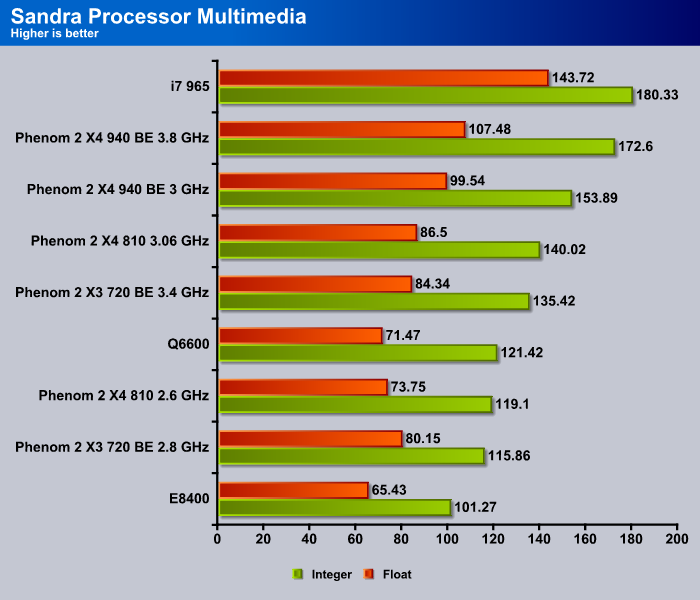
In our last test, before moving on to the Overclocking section the Core i7 965 tops the chart followed by the Phenom 2 X4 940 BE both overclocked and stock. Behind the X4 940 BE the X4 810 OCed followed by the X3 720 BE OCed then the Q6600. With the E8400 staying consistently close to the bottom of the charts due to it’s dual core nature it quickly becomes apparent which CPU’s will be more beneficial in a multi-threaded environment. We had to toss that in to get a little of the Dual core is good enough crowd VS the Quads rule crowd chatter going. As applications become more multi-thread capable we can foresee the day when Dual Core CPU’s go the way of the single core CPU.
OVERCLOCKING
Phenom 2 X4 940 BE
We’ve got a lot to cover in the OCing section so lets kick it off with the Phenom X4 940 BE CPU-Z Story.
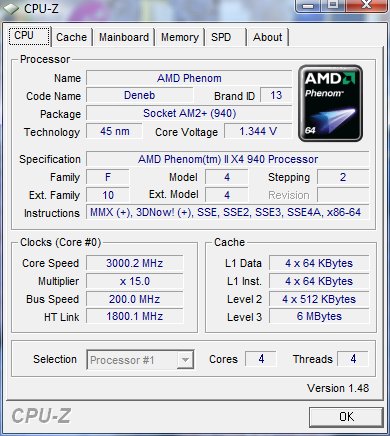
Our first shot from CPU-Z shows the Phenom 2 X4 940 BE at it’s stock settings, we just slapped it on the board and fired it up and this is what CPU-Z reports. A nice comfortable 3 GHz out of the gate with no overclocking.
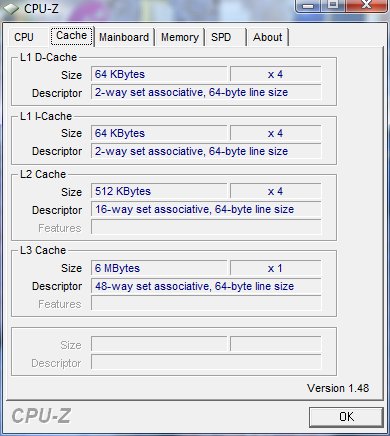
The Cache tab shows us that we’re looking at 6 MB of L3 cache and 2 MB total L2 cache. Grand total between L2 and L3 cache a hefty 8 MB. We’re glad to see the increased cache size on the new Phenom 2 series.
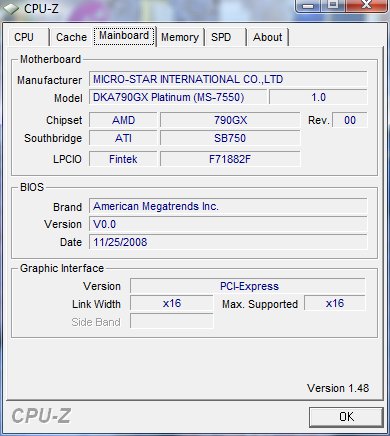
On the Phenom 2 940 BE we went with the MSI DKA790GX Platinum motherboard, the Asus board and MSI board we used for the AMD CPU’s both feature the same 790GX and SB750 AMD chipset. We would have preferred to have them all run on the same board but 3 CPU’s at once with 3 Intel rigs is a daunting task and for times sake we had no choice but to split the boards on the AMD CPU’s. We actually like the Asus board a little better for no other reason than we’re more used to Asus BIOS layout as you’ll see in just a little bit the MSI board is a quite capable OCer board, but we had to work harder to get the OC on the MSI board and the bulk of our overclocking time was spent on the big dog Phenom 2 X4 940 BE.

Both the Asus and MSI board gave us a little guff when it came to attaining the Crucial Ballistix’s rated speed of 1066, in both cases we had to set the ram timings and voltage manually and up the NB voltage just a tad to get the ram stable. Both MSI and Asus assure us that this is just an early BIOS issue and will soon be resolved.
Now lets take a look at the 3.8 GHz CPU-Z Screenie which is the speed we tested at.
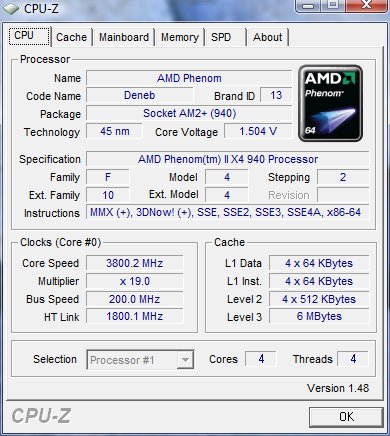
We were able to hit 3.8 GHz pretty easily which is why we tested at that, with good cooling you can reasonably expect to be able to hit 3.8 with a good motherboard and an investment of time and effort.
Then lets look at the CPU-Z screenie for our maximum OC in AMD OverDrive (AOD).
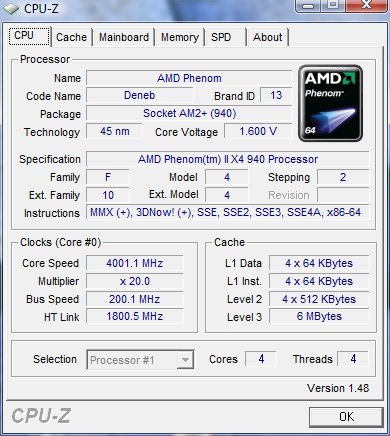
We did a lot of testing of OC settings in AMD Overdrive until we maxed out the voltage available, then we set voltage high in BIOS and tested settings with the voltage higher than we like until we stabilized at 4 GHz.
Then lastly lets take a look at our CPU-Z BIOS OC screenie.
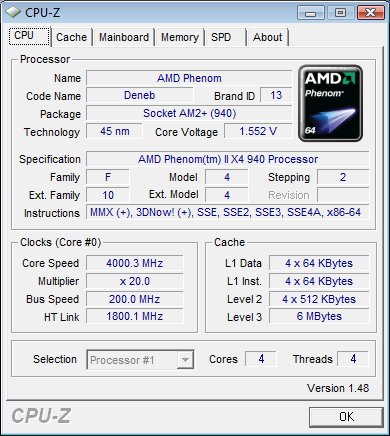
Then once we had stability (in AOD) with ample volts we went ahead and put the information into BIOS and kept reducing voltage on the CPU until we threw a blue screen then upped it a couple of notches, ran Prime 95 for a couple of hours and 4 GHz ran nice and stable at 1.552 Vcore. Please be aware that we went to a high end water cooling system to attain this OC and it did take considerable time and effort to achieve. Is there more to get from the Phenom 2 X4 940 BE, yes you can achieve higher OC’s depending on your setup, cooling, and willingness to put in the time and effort. It took about a week to reach 4 Ghz stable under water spending 2-3 hours a day for the entire week until the 7th day and we spent about 6 hours on day 7 stabiizing and testing. Do we intend to run it at 4 GHz 24/7, no we have no intention of running it at 4 GHz 24/7 extreme Overclocks are best for benching then returning to a reasonable overclock which we consider to be 3.8 GHz.
Most time efficient means of overcocking the Phenom 2 X4 940 BE was testing in AMD OverDrive then running Prime 95 for stability testing. After stability testing the AOD settings entering them into BIOS and booting into Vista and Priming the system with the BIOS OC. You should be aware that we were able to get away with some things in AOD that didn’t fly in BIOS OCing and required some minor tinkering in BIOS to stabilize. You can expect that, software OCing is a different ballgame from BIOS OCing. AOD testing was good for giving us a quick and dirty testing method for rough BIOS settings.
To have any reasonable expectation of a good OC on the Phenom 2 series CPU’s we highly recommend the 790GX and SB750 chipset boards. The best, most reliable, overclocking results we got and have seen in our research are on boards with the 790GX and SB750 so don’t be suprized if you try it on a board without those chips and can’t achieve simular overclocking results. Remember OCing is a crap shoot, will most likely void your warranty, and if your not OCing RockStars like we are results may vary.
OVERCLOCKING
Phenom 2 X4 810
Lets jump right into the CPU-Z story on the Phenom 2 X4 810.
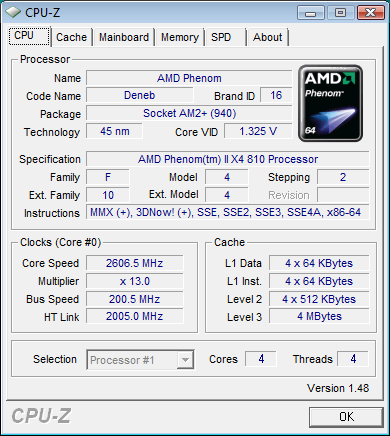
The Phenom 2 X4 810 would be a mainstream Phenom 2 X4 and has a locked multiplier, it’s stock multiplier is 13 and can be set lower but not higher. Stock speed on this one is 2.6 GHz and you’ll have to make your selection of motherboards carefully because the OC on this one is strictly tied to FSB speed the motherboard can achieve and hold. Needless to say OCing will take more time and effort and is less fun than OCing the unlocked multiplier version on Phenom 2 Black Editions.
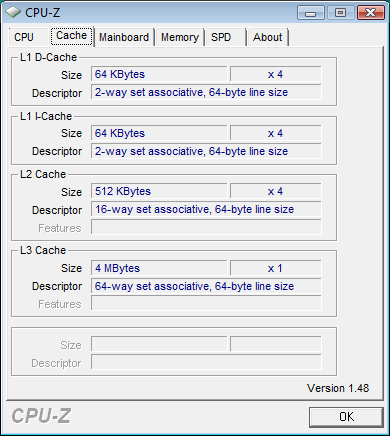
Since it’s a mainstream version of Phenom 2 X4 cache on the X4 810 is reduced to 4 MB L3 cache.
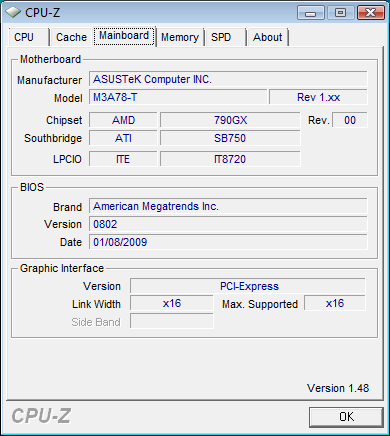
We went with the Asus M3A78-T on the Phenom 2 X4 810 testing, like we mentioned earlier if you plan on serous overclocking we recommend a motherboard with the 790GX and SB750 chipset. The M3A78-T has a somewhat immature BIOS but we expect good things from the board as soon as it has a little BIOS maturity under it’s belt.
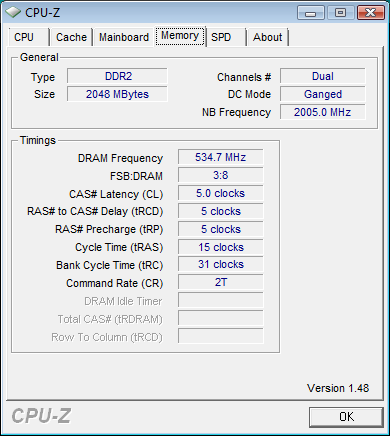
Same story on the memory on this board, due to a BIOS glitch it want’s to down clock the 1066 Crucial memory to 800 MHz unless you set it manually. To make the 4 GB kit entirely stable we had to fiddle with NB voltages a little and set timings and speed manually.
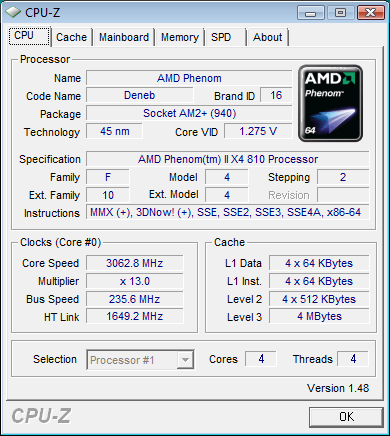
After some tinkering with voltages we were able to hit 3.063 GHz without increasing the Vcore voltage. We did have to tinker with and adjust other voltages and use a divider on the ram and Hyper-Transport Link. You can probably achieve a higher overclock than we did because we had a very limited time to work with 3 CPU’s spread across 2 boards. As soon as we tried to go to 3.1 GHz we spent about one full day trying to stabilize it and finally touched 3.2 GHz and booted into Vista at 3.2 GHz but didn’t have time to try and stabilize it. This ones not as much fun to OC as the Black Edition Phenom 2’s but if you don’t mind spending the time and doing some tweaking you’ll get a pretty decent OC.
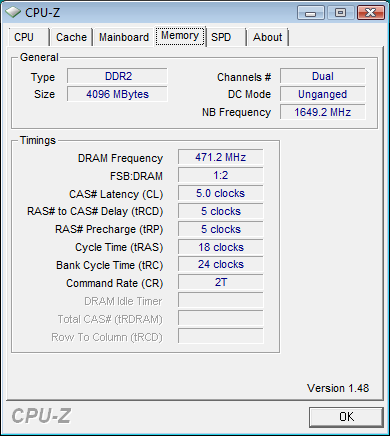
Like we mentioned, best results for efficient overclocking were done in AOD then enter the settings into BIOS manually. In order to take the ram speed out of the equation we used a divider to reduce the ram speed to 800 MHz then let the FSB OC raise it back up to 942. On a kit like the Crucial Ballistix 1066 we used it wouldn’t be hard to OC the CPU and Max the OC on the ram achieving a little better OC. You will probably also want to reduce the Hyper Transport link speed during overclocking, going much past 2 GHz on Hyper Transport might de-stabilize or reduce your overclocking overhead.
Please note the the OC results on the Phenom 2 X4 810 are more a result of the limited time we had to work with it than the actual capabilities of the CPU itself.
OVERCLOCKING
Phenom 2 X3 720
Then the last CPU in the Phenom 2 lineup we tested was the X3 720 BE. We can feel comfortable telling you that of the Phenom 2 CPU’s that we tested that the Black Editions are highly recommended for the best and most fun overclocking and if you plan on serious overclocking on the Phenom 2 series we recommend the Black Editions and the 790GX and SB750 chipset. Yes we’ve repeated that several times but we already know that if we don’t pound that point home there will be people come back to us and say, “I couldn’t get it to OC like you did can you help me?” We can help to some extent, but not if you chose to go with a different chipset, we haven’t tested on anything but the 790GX and SB750 chipset so we can’t tell you if it will OC on any other chipset, or how well it will OC. We will more than likely test on an AM3 board when one comes available but these CPU’s are designed for and run best on the AMD 790GX and SB750 chipsets that are currently available. Then lastly no we can’t predict if they will run better or worse on future chipsets, we can tell you that on the chipsets we tested, especially with the Phenom 2 X4 and Phenom X3 720 Black Editions it was a lot of fun overclocking, and games and applications ran like glass on them. Beyond that overclocking is a crapshoot heavily dependent on time, skill, and careful selection of hardware.

We’ve got to hand it to AMD when it comes to base clockspeed on the new Phenom 2 CPU’s, they’ve made a much needed and greatly appreciated clock speed increase on this series. For the average gamer wanting to run games and have a little extra punch when it comes to multi-threaded applications it would be hard not to recommend the Phenom 2 X3 720 BE. Most games use 2 cores efficiently but when you get past two cores (currently) most of the cores are wasted and just kind of hang around out there and idle. The Phenom 2 X3 720 BE provides a good balance of power and price. Not as expensive as it’s big brother the Phenom 2 X4 940 BE which is limited to the AM2+ boards, the X3 720 BE is AM3 board capable but backwards compatible with the AM2+ boards and features the unlocked multiplier that make it exponentially easier to enjoy OCing ease. We had a lot of fun with the X3 720 BE and fully intend to push it farther than we already have.
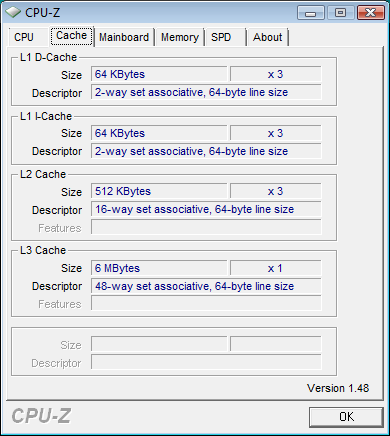
Since it’s a Triple Core Black Edition it gets the advantage of having a full 6 MB of L3 cache.
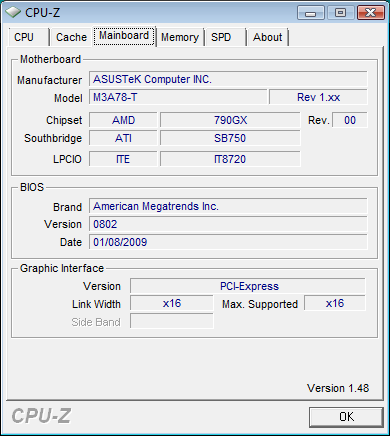
Again we went with the M3A78-T board for the Phenom 2 X3 720 BE and as we mentioned for no other reason than we’re more familiar with the Asus boards BIOS setup than the MSI boards BIOS. If you remember back a page or two we were able to stabilize the Phenom 2 X4 940 at 4 GHz on the MSI board so it’s no slouch. In general though we find that it’s easier to attain a good OC if you use one vendors boards and get to know the inherent tenancies of that manufacturers boards as opposed to going all over the map and playing on every vendors boards. In other words pick a flavor, pick a good flavor and stick with it, with experience on a particular vendors boards every OC gets easier.
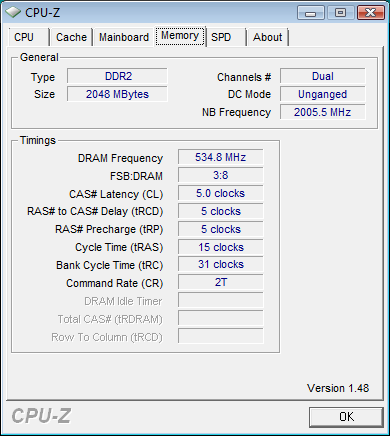
Changing CPU’s didn’t make the BIOS recognize and set the ram speeds correctly so we had to set them manually and tinker with the NB voltage a little to get the ram up to, and stable at, 1066.
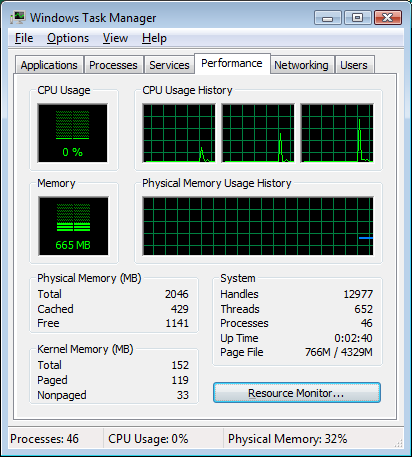
Yes we know this isn’t a CPU-Z shot it’s a task manager screenie but we just couldn’t get over seeing 3 cores in task manager and if you’ll notice all three cores were responding and working just like they should. The little spike you see there was a short burt of multi-threaded activity in Everest’s CPU testing suite, then we aborted, dumped out and grabbed the screenie to see if all 3 cores were active and we were rewarded with a spike in all three task manager windows. Most of the OCing we did we started with a 2 GB kit of Crucial Ballistic DDR2 1066, then when we got to the CPU speed we wanted we switched out to our 4 GB kit and tinkered with voltages to get the ram stable. One of the little secrets to our Overclocking success.
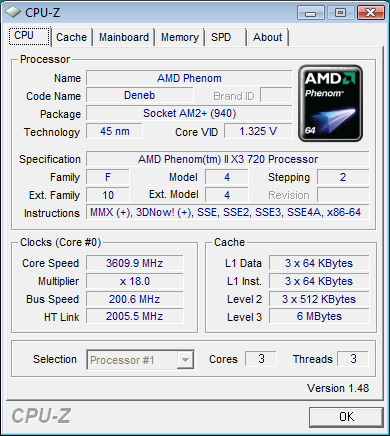
While we tested at 3.4 GHz shortly after we got all the charts made we got bored and went back and tinkered with the Phenom 2 X3 720 BE a little more and in a short time we hit 3.6 GHz stable. Please note that this was an early screenie of our success at 3.6 GHz and the actual voltage that stabilized it was more like 1.39 Vcore. That’s a nice little speed increase of 800 MHz and we’re reasonably sure that with a little more time and effort, with good cooling 3.8 GHz and beyond is obtainable. We consider 3.6 GHz a good and reasonable OC to run 24/7 and anything beyond that should remain in the realm of a temporary boost for benching and bragging rights.
CONCLUSION
There are a couple of ways to see the Phenom 2 series of CPU’s. The die hards will scream that they’re not up the standards of the Intel Core i7 CPU’s. We didn’t expect them to be up to the performance of Core i7. We did expect them to be up to the standards of the Core 2 Duo and Core 2 Quad series Intel CPU’s and they achieved that expectation. This technological advance for AMD represents the largest single computational increase in computing power in AMD’s history. While not up to Intel’s Core i7 performance levels the AMD Phenom 2’s and Dragon platform aren’t up to Intel’s Core i7 price levels either.
The Phenom 2’s come in at a good price/performance level and fill a much needed price point that has up until now has been lacking in computational power. Once again you can build a reasonably powerful system that will game and perform well enough to satisfy most enthusiasts without having to sell your kidney. That’s the true victory with the Phenom 2 CPU lineup. Performance at a price you can afford, and in the current economic downturn it was a much needed and awaited victory.
The Phenom 2 lineup in general was fun to overclock, the Phenom 2 Black Editions were a lot more fun to overclock so we highly recommend those if your into serious overclocking. They respond well to good cooling and we saw more overclocking overhead when we switched out to our high end water cooling system, but a good Air cooler like the Thermalright Ultra 120 provides enough headroom for most people to be happy with.
There’s more to CPU (and hardware) evaluation than just benches and overclocking, in order to evaluate it you also need to run it in day to day computing, and game on the platform to get a feel for it. We loaded up our favorite games including Crysis, Warhead, World In Conflict, FarCry 2 and a few others and gamed for a couple of hours in each and we’re happy to report that the Dragon platform ran the games and applications we tried as well as any machine we’ve had on the bench. Considering we have access to machines that fully dressed out cost as much as $4000 that’s saying a lot. (Yes QuadZilla fully dressed far exceeds $4k but we have some surprises on QuadZilla you haven’t seen yet)
With the economic down turn the great price/performance of the Phenom 2 CPU’s and Dragon platform is a welcome sight to cash starved consumers and we don’t have a problem recommending it from that standpoint. We fully expect a lot of consumers to take to the new Dragon platform eagerly and welcome both it’s computational power and price.
We are trying out a new addition to our scoring system to provide additional feedback beyond a flat score. Please note that the final score isn’t an aggregate average of the new rating system.
- Performance 8.5
- Value 10
- Quality 10
- Warranty 8
- Features 10
- Innovation 9
Pros:
+ Great Price/Performance
+ Nice OCing Headroom
+ Responds Well To Advanced Cooling Methods
+ Best Performance From AMD We’ve Seen To Date
+ Very Stable When OCed Properly
+ Fun To OC Black Editions
+ Entire Top End Dragon Platform Cheaper Than A Single Intel 965 Extreme CPU.
Cons:
– Haven’t Caught Up To Core i7
For it’s Excellent Price/Performance Ratio, running all our games and applications at a more than acceptable speed, and whole Platform Concept (Dragon Platform) the Phenom 2 series CPU’s deserve a
Final Score: 8.5 out of 10 and the Bjorn3D Seal Of Approval.
| CPU Name | Cores | Clock | L2/L3 Cache | HT Bus | Socket | TDP | Price |
| AMD Phenom II X4 965 BE | 4 | 3.4GHz | 2+6MB | 4000MHz | AM3 | 140W | $179 |
| AMD Phenom II X4 955 BE | 4 | 3.2GHz | 2+6MB | 4000MHz | AM3 | 125W | $165 |
| AMD Phenom II X4 945 | 4 | 3.0GHz | 2+6MB | 4000MHz | AM3 | 125W | $159 |
| AMD Phenom II X4 925 | 4 | 2.8GHz | 2+6MB | 4000MHz | AM3 | 95W | $139 |
| AMD Phenom II X4 910e | 4 | 2.6GHz | 2+6MB | 4000MHz | AM3 | 65W | $169 |
| AMD Phenom II X4 905e | 4 | 2.5GHz | 2+6MB | 4000MHz | AM3 | 65W | $175 |
| AMD Phenom II X4 810 | 4 | 2.6GHz | 2+4MB | 4000MHz | AM3 | 95W | $139 |
| AMD Phenom II X3 720BE | 3 | 2.8GHz | 1.5+6MB | 4000MHz | AM3 | 95W | $104 |
| AMD Phenom II X3 710 | 3 | 2.6GHz | 1.5+6MB | 4000MHz | AM3 | 95W | $99 |
| AMD Phenom II X3 705e | 3 | 2.5GHz | 1.5+6MB | 4000MHz | AM3 | 65W | $119 |
| AMD Phenom II X2 555 | 2 | 3.2GHz | 1+6MB | 4000MHz | AM3 | 80W | $99 |
| AMD Phenom II X2 550 | 2 | 3.1GHz | 1+6MB | 4000MHz | AM3 | 80W | $91 |
| AMD Athlon II X4 635 | 4 | 2.9GHz | 2MB | 4000MHz | AM3 | 95W | $120 |
| AMD Athlon II X4 630 | 4 | 2.8GHz | 2MB | 4000MHz | AM3 | 95W | $102 |
| AMD Athlon II X4 620 | 4 | 2.6GHz | 2MB | 4000MHz | AM3 | 95W | $99 |
| AMD Athlon II X3 440 | 3 | 3.0GHz | 1.5MB | 4000MHz | AM3 | 95W | $84 |
| AMD Athlon II X3 435 | 3 | 2.9GHz | 1.5MB | 4000MHz | AM3 | 95W | $75 |
| AMD Athlon II X3 425 | 3 | 2.7GHz | 1.5MB | 4000MHz | AM3 | 95W | $72 |
| AMD Athlon II X2 255 | 2 | 3.1GHz | 2MB | 4000MHz | AM3 | 65W | $75 |
| AMD Athlon II X2 250 | 2 | 3.0GHz | 2MB | 4000MHz | AM3 | 65W | $65 |
| AMD Athlon II X2 245 | 2 | 2.9GHz | 2MB | 4000MHz | AM3 | 65W | $61 |
| AMD Athlon II X2 240 | 2 | 2.8GHz | 2MB | 4000MHz | AM3 | 65W | $53 |
 Bjorn3D.com Bjorn3d.com – Satisfying Your Daily Tech Cravings Since 1996
Bjorn3D.com Bjorn3d.com – Satisfying Your Daily Tech Cravings Since 1996





